#and he has amazing unity tutorials
Explore tagged Tumblr posts
Text
youtube
I am ecstatic!
#gamedev#he’s finally back!!#brackeys inspired me to start game dev#and he has amazing unity tutorials#game design#programming#codeblr#brakeys#Youtube
4 notes
·
View notes
Text
I'm baaaack
can't catch a break from my wifi, it just dies for entire weeks sometimes >:(
I'm trying to fix it
but I have made some progress on the Ivory Game, it has a sonic, and he can stand on the ground :D
I haven't made a player controller yet, but csharp is hard and I've never used unity before, so having something at all is amazing for me
super excited tho, and bc my wifi is kinda back I can download more tutorials yippee
3 notes
·
View notes
Note
I hope you don't mind I've been rotating this headcannon in my brain like a rotisserie chicken -
I just imagine Patton looking up the tutorials and seeing all of the gigantic cuffs people make and trying all kinds of patterns, and Virgil's other friends start asking to meet the guy that is making all his cuffs, and it takes some needing but finally Virgil convinces Patton to come to a party, promising it's small(er), and there's a side room he can go to if he gets overwhelmed.
And Patton has a bunch of his bracelets in a bag at first, and he sticks to Virgil's side like glue for a while, and he's just dressed in plain clothes. But someone hands him and Virgil some glow sticks, and there's glow in the dark face paint, and Virgil gets Patton to wear some of the cuffs he brought and gestures one of his other friends to come over and they teach Patton PLUR (the gestures you do to trade - peace, love, unity, respect) and swap bracelets and Patton just gets really into it and trades with a few people (someone gives him a necklace with a big stuffed animal on it - i saw some of those looking for that video i mentioned and i was instantly like yes perfect) and at the end of the night he's a little tense because that was a *lot* of people, and it's late, but he's happy, and can be proud of himself for trying something new, and he wears all of the bracelets to school that Monday to show off to Logan and Roman. 💜💜
Also here are two from my collection - my two favorites minus the original (which is in my trinket box and not unpacked yet):

The bottom one is based on the core four! Virgil, Patton, Logan, and Roman. I had it made when I first got into TS (I won't say when, because then I'll feel old 😅)
And this is one that just absolutely amazes me:

So I had a thought, and you can totally ignore it if you want because it may be inaccurate - BUT I wonder if you're familiar with one of the "scenes" at some punk/rock/Rave events called Kandi. ((Mostly raves but still.)) ((Pronounced Candy. Those big chunky bead bracelets that look really cheap but some people make really epic ones)). The general theme is sharing friendship, love, and community unity! I saw all of the bracelets on Patton (I'm glad he has his friendship bracelets 💜) but it made me think about if that's one way Virgil and he started bonding - Virgil complimenting his Kandi and Patton being utterly confused at first [source - me and one of my boyfriends in highschool who is still a good friend of mine now. I was "Patton" and I still have the bracelet he gave me]. Then Patton starts making/wearing more complicated designs and sometimes gives them to Virgil to take and trade at events.
Idk I've always thought that was a really fun thing people do and the way you've set up their personalities feels like it would fit really well.
(also if you want better explanation, look up Kandi and Kandi trading. There's this cool thing where the two people hold hands a certain way and you transfer the bracelet from one wrist to the other. I wish I could find the video of this one really sweet epic trade of an absolutely gigantic bracelet. Anyway 😅)
I was absolutely NOT familiar of Kandi bracelets; I’ve seen them but I had no clue that this was the association with them!!
This is so so cute and thank you SO much for telling me about this!! I will absolutely be incorporating kandi into their dynamic cause this is so gosh darn precious🥺🩵💜
#warcats asks people#i found my kandi last night ☺️#I've never gotten to exchange them#because ive never been to a rave#im way too easily overstimulated#but i never forgot him showing me#i wish i was a little braver#i did get a compliment from a lady once#while i was at work#that she liked my kandi#and i smiled about it like all day#ok im done now i promise#sanders sides au#nyah au#platonic moxiety#(i hope that last tag is ok!)#patton my beloved
10 notes
·
View notes
Note
Can you rant about pkmn sword? Rants are enjoyable to read
Alright, so it took me a bit to get my thoughts in line. Lets start with how I feel about the pricing: I am all for having 30 euro DLC over a third version for the full price, however, I do think that if they do that, as well as with the dex cut, they should quit with having there be two versions. Nowadays, with internet communication, it doesn't really do much for social interaction, it's just another hurdle for those of us who wish to complete the pokedex(and especially when they remove the GTS and make you pay for it later). It's still a scummy tactic, and no one will complain if there's just one version+DLC. It makes a big difference in the pricetag, since being forced to buy nintendo online, or two switches and two games to trade, are both mandatory payments to make in order to achieve one of the encouraged goals within the game. Furthermore, people within one family will likely be using the same cartridge, so if there is only one version, all in all, it'll make a huge difference for people who use a whole switch as a family as well. Also, I do not think that sword and shield are worth 60 euros. I think they're worth 30 at most, since the base game is worse than x and y/sun and moon. They also locked following pokemon behind a paywall, which is bullshit and yeah, fuck that. I think swsh are enjoyable, but not when they sell at the same price as games with way more content, games that look much better, and usually both combined. For what the switch can do, swsh look really bad, actually. There are a few pretty spots, but that's the exception, not the rule. To add on to things that I think are horrible; the raid battles, especially the more difficult ones, in single player. I don't have switch online, and as such, I need to do all raids alone. But, the raids are near-impossible in a lot of cases unless you get really lucky with the npcs and ai. I got two gmax Toxtricity by using wide guard with Zamazenta for over four hours until I finally got lucky for each. This is both to blame on the ai, and the horrible selection of pokemon. Pokemon that should have evolved at level 60, well, they are still in their first form, so you have magikarp and mudbray at a 5 star raid. At least have them evolved. They have good moves, yes, but their base stats are so low that it doesn't matter. Also, the shield mechanic. It is predetermined how much damage you can do, and if you land a supereffective hit, it's not unlikely for it to only do a sliver of damage and then the shield goes up. It's annoying, makes battles extremely difficult because a lot of npcs just won't attack while the shields are up, and it just becomes a waiting game if your pokemon is just there to act as support(such as my Zamazenta with wide guard to prevent Toxtricity from 2-hit ko-ing all my teammates). Also, the fact that even if you beat a gmax pokemon, there is still a chance not to catch them. It often takes ages to even defeat them, and then, 'Congratulations! You just wasted over half an hour of your life! Get fucked!'. I had this happen with Applin t w i c e. Also, the wild area is... It's okay, really. Nothing exceptional, my immersion is ruined by the sheer amount of pop-in, something that happens even when there aren't a lot of models on-screen, the Onyx in Motostoke being a rather infamous example. The trees look like shit, the berry trees look like they don't belong, to put it bluntly, it looks like something a student would make in unity. You'd expect something better from the highest grossing franchise in the world. The ai of the pokemon is often pretty bad, with them just moving in circles, I have seen so many synchronized pokemon at this point that it's just... Egh. Also, the customization options are still so limited? Can't choose eyeshape, can't choose clothes that actually make your character stand out, and you can't even choose your challenger uniform after you become the champion. Why does Leon get a special uniform? I have never seen a pokemon game so set on making you feel like a celebrity after you win, yet you don't get to have much of an identity in the game even after you win. It didn't have to be difficult, just a customization screen inside the dressing room of the Wyndon stadium, perhaps some extra clothing options? As for things I like: I like the atmosphere. The music, though sometimes repetitive, does help my immersion. The gym leader theme is dynamic, shifting with what happens in the battle, making me feel like I'm actually standing there, and the ambient themes work well as well, though those were rarely encountered at all. I love the characters, the trainer cards giving you some backstory on them, they are, together with the Unova leaders, the most present gym leaders today, with a history of their own. It felt amazing to just read the trainer cards(and I enjoyed making my own as well). The towns have their own themes, and while I can't remember the names, I do remember each location well. But. There was so much wasted potential. The castle in Hammerlocke? The large building in the east? Hammerlocke's castle: the vault, 1 room and a roof. The large building? Nothing. You don't even get to see the attraction inspired by the London Eye. Wyndon is so small??? It has a small shopping street, the stadium and the inn and that's about it. Castelia City was bigger than that. Overall, the game feels rushed. The gym challenges at the start were cool, but by the end it's more of "battle these trainers in a row haha". Also, the animations. Gamefreak claimed to need to remake all models(they did not, the 3ds models were used with better textures), and to make better animations(only for newer pokemon, most pokemon used their pokemon amie animations and further animations from the 3ds titles). The animations are still bad, especially for something as powerful as the switch. I enjoyed the lore behind the region, but I really, really dislike Dynamax. I like gigantamax because the pokemon usually changes in a way that is distinguishable, but regular dynamax... Nah. Give me mega evolution back, perhaps update its mechanics so it changes the gameplay more and requires more strategy, but Dynamax just feels like something that is so low-effort. Pokemon but beeg. The curry making, on the other hand, I love. Pokemon should not be a cooking game, but it made me feel like I was actually bonding with my pokemon, that they were present in the mc's daily life. I would love to see more additions like that, the possibility to become the kind of trainer you want. Enjoy swimming? Perhaps go for a swim with your pokemon? It doesn't need to be complex, but I'd just love to see my pokemon interact with each other and with my actual character more. The routes are too linear. The last route is literally a straight line with some trainers, with next to no effort in it. I also think that the handholding needs to be talked about. When you get to Motostoke and have signed up for the gym challenge, a staff member will lead you to the in, which is literally one screen to the left. Such examples are found all over the game, and I hate it. They do let you skip some tutorials, which is a welcome change, but characters are so willing to force you to stop with whatever you're doing and make you listen to their speeches that it still often feels like a slog, especially because you don't get to do shit besides gyms until the very, very end, in which the fucking champion tries to catch a legendary in a regular pokeball, not even a great or ultra ball. The lore is great, but the actual story is so nonsensical that I just didn't bother to pay attention. Hop literally recycles Hau's animations. I would love for him to have his own, so he'd feel more separate, because they ARE different characters, with different goals. But Hop is even more annoying than Hau because he just won't shut up. You walk 5 steps and he shows up somewhere, for no reason at all. Meanwhile, there's this big event going down, a crowd has gathered, you get there and... Leon has already resolved it. You just get a picture, that was what you wanted, right? That sums up most of the game 'the adults will deal with this!' . The picture doesn't even look good. Swsh is fond of just showing you pictures, for example, right before the climax when Rose and Leon are talking. There's no background music or anything, just pictures and the sound of the textbox. It feels so low-effort. Also, if you have a character that is a singer, and he uh, he sings, it MAY be a good idea to include VOICE ACTING. They had someone sing in Black and White 2! Surely they can do it on the fucking switch, several years later? The mouths flapping about just feels incredibly awkward. I would recommend the game if you can find it somewhere for cheap, not for the full price. There is enjoyment to be had, but it's subpar in comparison to other games for the same price. I may rant further depending on how much time I have.
9 notes
·
View notes
Text
Meet PlaceRebuilder, Gyazo Explore winner and creator of Reason 2 Die in Roblox

Today we have an interview with Andreas AKA PlaceRebuilder, an independent game developer working on Reason 2 Die, a popular game made with Roblox. He recently won our grand prize by sharing Gyazo game captures that got the most reactions within one month.
Sharing game moments with Gyazo takes seconds, not minutes, and it can increase your followers plus keep them engaged. See what’s happening in Roblox, League of Legends, and Fortnite on Gyazo Explore.
And now, on with the interview.
Can you tell me a little about your background? Are you studying or working right now?
My name is Andreas but I go under the alias of PlaceRebuilder. Sorta like Neo, except instead of being a super cool Kung-Fu fighter, I do games on a kids website. At the moment I’m not ‘actively’ studying, I’m on a break. I do some exams here and there and might jump back in later full-time.
I’m currently developing the game Reason 2 Die: Awakening. A Roblox zombie shooter game that’s been sort of a franchise ever since I was a kid. I created the first version over 10 years ago and today’s version ‘Awakening’ has been under development for about 4 years.
Which apps do you use every day / couldn't live without?
Roblox. Literally would be flipping burgers at McDonalds unless I had discovered how to make games on that site. Gyazo I probably COULD live without but it would make the progress of sharing current development much more boring. I would only post pictures on my twitter, not fancy gifs.
Why do you think Robloxians use Gyazo to share so much?
It’s a super easy tool to fast record your screen without having to save 14GB of .avi footage on your computer like Fraps. Then easily getting a link to share with anyone is just perfect!
What do you like most about roblox? Is there something special about it compared to other games?
The simplicity and ease of use is the reason I got engaged in making Roblox games. I would be interested in making unity games as well, but there’s something about having your custom-made character available in almost any game that gives Roblox the charm that other game platforms don’t have.
My PlaceRebuilder character is clean and iconic. Being able to play a completely different game and still keep my character appearance is one of the best parts of Roblox.
My roblox character, PlaceRebuilder:

What would you like to tell Gyazo users and game fans about the game you’re working on? Can you share any details about the future of the project?
Oh boi, my favorite part of this whole interview!
How would I best describe Reason 2 Die? It started off as a fan-made ‘Left 4 Dead’ game, hence the name Reason 2 Die. Besides just shooting zombies we’ve had several holiday events like Halloween and Christmas in which unique maps and Quests are added and one-time-available mounts and costumes can be obtained.
Reason 2 Die is primarily a blocky zombie shooter but occasionally I find some funny random item to add into the game that otherwise wouldn’t fit a conventional post-apocalyptic genre. One example of this is the Christmas toy plane that could be acquired during the Christmas Event 2019.
Or the Freedom flag for sale during Thanksgiving
These don’t necessarily help with completing the objectives but flying a toy plane far above zombie hoards is still such a joyful feeling!
The future of Reason 2 Die is found in new players. Right now I’m reworking the gameplay, stats and contracts as well as adding a fancy tutorial headsup to teach everyone how to play with ease.
We have some events like ‘Summer Event 2020’ coming up, but primarily I want to focus on developing a fun campaign-driven gameplay. We’ve had like 13 events (according to our wiki) and I’ve really enjoyed them all but this year I’m going to focus on gameplay instead.
What are some challenges you have with your project?Anything Gyazo could help with?
It’s sometimes difficult to record with Gyazo because if something happens in-game then don’t have time to open Gyazo, select the area to record and then start recording. By the time you’ve done that the thing you wanted to record is already gone.
Be sure to check out Gyazo Replay for reliable in-game capturing.
If you could add one feature, what would you add to Gyazo and why?
I’d like Gyazo to have an option to pre-select the area you wish to record, then choose (with a key) when to start and stop recording. That way you could easily record highlights of your gameplay without getting headshot by a sniper for standing still trying to open the GIF program.
Nice idea! I'll pass that on to the team.
If you look back to when you started playing Roblox, where did you think you would end up? What would be a dream or perfect result for you?
Back when I started it was just for fun, there wasn’t even an option to make any money out of it. Then I became a broke student and heard that you could make some money from Roblox games and I came back and started creating games again.
I think the perfect result would be when I have over 100k players online and I’m top popular aswell as top earning game on Roblox. It’s not so likely to happen but a man can dream, ok?
Go for it. You can get there if you keep working and moving forward.
Is there anything you would like to say to the Gyazo Team, Gyazo users, or the gaming community in general?
I want to say thanks for the chair, it’s really flexible and my previous chair was super old and hurting my back. It’s always amazing to win a contest you didn’t know you signed up for!
And a special shoutout to my community, your support makes R2DA developing fun :)
That’s all for our interview. What gaming chair did he pick?
With $400 gaming gear to chose from he picked the Omega 2020 Stealth Gaming Chair from Secret Lab:
Congratulations to PlaceRebuilder and I hope it was interesting for you out there reading to see how one game developer is using Gyazo to engage fans and build his brand.
Check out PlaceRebuilder and Reason 2 Die: Follow him on Twitter Try Reason 2 Die in Roblox Join the Reason 2 Die Discord
4 notes
·
View notes
Text
Assassin’s Creed: Unity Review
Did I ever post my Unity review? No? Well here’s my Unity review.
The game is bad.
I think that Assassin’s Creed: Unity is quite frankly the most infuriating game I’ve played in years.
When I’d gotten a PS4 I decided I was going to get one of the AC games that was on PS4 that wasn’t Odyssey (because I already had obtained it and loved it). And I got Unity because I’d heard the free-running was better, and that when played well it was quite good. And while traversing Paris is fun, this game also sometimes plays as garbage and I’m kind of baffled about some of the decisions they’ve made designing it.
You see, this is my experience in playing just about every Assassin’s Creed game: try to be sneaky around the guards, but when that inevitably fails I kill them all. I was starting down this path in Unity when the game stopped me.
“Hang on a sec, you can’t do that,” the game said. “Why not?” I asked. “Because we’ve designed the combat to be utter garbage!” the game joyously exclaimed, laughing maniacally. And it wasn’t lying. The combat is utter garbage and I got killed pretty quickly. The parry is too clumsy for the careful timing it sometimes requires, you’re practically defenseless against guns, and counter kills have been removed. I get the point, of course: the game wants you to try more stealthy approaches, and so if you get detected you’ve got to retreat and rework your approach. But it was just completely at odds with how I played these games. I felt as if the previous games went out of their way to make you feel like a badass warrior and then Unity goes out of its way to make you feel as weak as possible. And for a game that makes you want to avoid combat like the plague, it keeps putting you in it. “But stealth!” the game and its fans reply. Which doesn’t work for me, because the Batman: Arkham games had amazing stealth sections that rely on not getting caught, but the combat isn’t utter crap. If there’s a part of the game you’re hoping people will avoid, maybe you should realize that it’s because that part of the game is terrible and need reworking, not that you’re clever for designing it so. “I actually really liked the combat,” says Unity fanboy #463 on Reddit. Alright, but you do know you are admitting to enjoying something deliberately designed to be unpleasant? It’s a bit like telling everyone you enjoy the smell in gas station restrooms. It isn’t something you should really brag about. Unity fanboy #149 scoffs haughtily. “Well I want my games to be challenging, unlike a casual gamer,” he says. Good for you. But that defense doesn’t work with this game because I’m not just being challenged by the game’s combat difficulty, which is aggravating by design, I’m being challenged by the fact that the game doesn’t work. What makes the stealth and combat so aggravating is how glitchy the game is. At one point in a story-scripted fight Arno wouldn’t attack, block, dodge or shoot, and the only actions he could perform were walking around and dropping smoke bombs. Sometimes Arno refuses to shoot when prompted, as if the targeted enemy was just too cool to die. Sometimes enemies aren’t hurt by being shot. Once Arno refused to start sneaking. I accidentally got into conflicts because I shot guards in the back of the head and instead of dying they turned around and saw me. Every so often, a civilian will walk in front of the barrel of your gun because he or she is suicidal I guess. I bumped into a guard on the other side of a wall. Guards spawned from nowhere to fight me and then when I hid they went back across the street on the other side of a wall. A guard with his back turned saw me on top of a rooftop. Sometimes when you’re detected you have to fight the one guy who saw you, and sometimes you have to fight all of his buddies who also apparently know where you are as they run from all over the block. And on some occasions the guards on the first floor won’t notice if you fire a gun on the second. At some points smoke bombs work to make your enemies lose track of you; at others they won’t. Frequently I’d aim to air assassinate a guard only for the game to switch which guard I was targeting as I’m pressing the button. In short, even if the stealth and combat were fun, the fact is that when you begin either you never know what exactly you’re signing up for because it doesn’t work. And not in a good way, like the game surprising you with extra fun; it’s exactly the wrong sort of way, where you think your mission is to defend an army officer against royalists and because you make too much noise fighting the royalists then the army soldiers decide to kill you too. [Also, you’re encouraged to use smoke bombs a lot. Which doesn’t really sound that stealthy, if you think about it, because a giant cloud of smoking spontaneously erupting around a group of guards is the exact opposite of stealthy.] I’m sure some fanboy will try to assure me it’s my fault that the game doesn’t play well, and that it’s actually pretty well designed. To that, I answer: Cherry Bombs. See, the game gives you this stealth tool called the ‘Cherry Bomb’ which is essentially a firecracker that acts as a noisemaker--you throw it somewhere, it’ll make sparks and noise, and the guards will be distracted and go investigate. This replaces the ‘whistle’ function the past two games had to draw guards over to where you are. What the game doesn’t tell you is that the Cherry Bomb has to be within a guard’s line of sight. Which means if you’re hiding in a hallway and are trying to lure a guard from an adjacent room into the hallway, then the Cherry Bomb won’t work unless the guard can turn around and see it from his position. Otherwise, they may turn around in the direction of the noise, but won’t move towards it. It doesn’t matter if it’s right behind them, or right around the corner; if they can’t see the Cherry Bomb, it won’t work. Essentially, one of the key stealth tools you start out with is a noisemaker that only works if enemies can see it. A noisemaker that works by line of sight! No one can tell me that a competently-designed game would include that! What makes stealth and combat even more difficult is that the game has what it calls “Crowd Events,” which are things that happen in the streets of Paris that you can interfere with, like someone getting robbed, or mugged, or bullied, or whatever. But in crowded areas this happens every minute or so, and even if you don’t interfere in the Crowd Event then the surrounding guards might take notice of someone in the street getting run through, and then a fight will break out and your stealth will be ruined because if you go anywhere near it the guards will detect you and the game will act like it’s your fault for not being sneaky enough. During one stealth mission three or four Crowd Events occurred within seconds of each other, with two spawning at once. They’re optional yes, but call me a moron because I always try to help when someone’s getting gutted on the pavement, which often leads to me being gutted on the pavement. There are times when the game doesn’t tell you what to do in specific situations and then acts like you should have known it all along. In Assassin’s Creed III it gives you specific instructions on what to do in combat when someone points a gun at you. Unity gives you no such help. I didn’t learn until I looked up combat tips for the game that you’re supposed to hit the dodge button at just the right second. Sometimes the game doesn’t give you enough time to realize that someone is shooting at you. If Arno is not in combat mode and someone’s aiming at you, you’re just out of luck, as the dodge button isn’t an option there. There’s an eye that appears next to the minimap, I think to tell you that you’re in a guard’s line of sight, but the game never tells me, so that’s just a guess on my part. The boss fight with Bellec has him disappear with a smoke bomb, and then he will try to jump on you and stab you, which the game doesn’t give any hint as to what you’re supposed to do about and it sucks because if he hits you then you die in one hit. There are skills and abilities that you have to unlock that you really shouldn’t. Double assassination is an ability that takes much too long to unlock; wisely the following game made this unlockable in the tutorial section. Guns have to be unlocked with skill points, which is downright weird; no other game in the series gives that limit, except as being a point of story progression. That you have to spend skill points to use one of the game’s basic weapons is downright offensive. The most infuriating thing is the admittedly rare occasion when the game punishes you for being smart. When you go to assassinate Marie Levesque, for instance, it took me a couple of tries, but I managed to sneak into the palace and take out key guards, noting the escape routes as I went. Only when I actually performed the assassination, all the open windows had been closed and all the guards I took out had respawned. Essentially, I had carefully planned an escape route and the game slammed that door in my face, saying, “Nope! For all our talk of doing it your own way, you have to get out of this situation the way we say you do, okay?” What kind of game punishes you for doing your homework? What is that supposed to teach me?
Customization is cool, in theory, but it’s also a major hassle. Because I just wanted to look cool, but instead I’m constantly juggling a bunch of statistics on how to be stealthy but also carry enough ammunition and supplies. It’s not helpful that if you want to be stealthy, the way the game wants you to play, the outfit most suited to that is the stupidest-looking one of the bunch. I didn’t experience any of the horrifying glitches of people missing faces, the way a lot of people did at the game’s launch. However, NPC bystanders would often walk through cutscenes, including duels and chase scenes, leisurely waltzing right through running characters or in front of enemies as they’re getting shot. There were a couple of scenes where the camera is at an extremely odd angle of someone’s face, with the corner of someone else’s character model in the way. Traversal is far better than previous games; at least, in theory. Most of the time it works, but when it doesn’t, it does so in the most rage-inducing way possible. Often Arno will climb up when you tell him to climb down. It’s not uncommon for Arno to refuse to climb up for no reason at all. If you’re running and you happen to dash past something that would realistically bump him in the shoulder, Arno will start climbing up it and refuse to get down, hopping from table to barrel to chair, including chairs that there are already people sitting in. More than once I was perched on a ledge and then Arno would just fall, arms flailing as he descended into a horde of angry enemies. When sneaking sometimes he just refused to take cover where I tell him to, and will instead just sort of rock back and forth on his heels like a moron or stick to a surface further away from him than the one I told him to take cover behind. “Just wait ‘til you see what we did with Eagle Vision!” the game says, clapping like a madman. I am very tired at this point. “How did you screw up Eagle Vision, that one button that makes it easier to see enemies and detect important elements around you?” I ask. “It’s on a short timer!” Unity is cackling now as it practically explodes with malicious glee. “And it has a cooldown period!” Yes, that staple of the series, Eagle Vision, is now only meant to last a few seconds. Certain types of gear will enable it to last longer and give it more range (WHY WOULD CHANGING YOUR CLOTHES ENHANCE YOUR SIXTH SENSE?!?), but it’s still on a timer, so in order to know where everyone is, you have to keep switching it on. You can see enemies through walls though, which is new and actually good. Optional objectives are back, and aren’t quite as bad as they were in previous games; they don’t have ridiculous conditions in order to get full credit, usually just things like “Do two double assassinations” or “Stun three enemies.” They’re still not great, because again, any idea of freedom is limited in that you won’t get 100% on a mission unless you do it a certain way. The worse is always “Don’t get detected” because this is always followed by throwing you into large spaces filled with half a dozen guards and no cover. You’re better off ignoring them. Hey, did I mention that the game never shuts up? Notifications float up in your face on the right side of the screen, and there is no way to dismiss them; you must wait for them to go away. Black Flag had this too, but those were always small enough that they didn’t get in the way of gameplay, and you could check the past few messages in the pause menu. In this game they’re constantly popping up to tell you tips, location, and useless information, along with a quick sound that pings every time to make sure you stay pissed off. They’ll often pop up on top of each other, so if you’re working on one of the Murder Mysteries and you look at a clue, a notification will pop up on top of the clue information to tell you information you already know and you just have to wait for it to fade away. And when you break a lock in the lockpicking minigame, the popup will helpfully tell you that if you don’t want to break locks, press the button at the correct time. Or, in short, if you don’t want to mess up, then don’t mess up. Thanks, Unity. Speaking of lockpicking, who’s bright idea was it to make it so that of the treasure chests littered across the map, two-thirds of them are locked? I get that in theory it means that there are collectables that you can’t unlock until you’ve progressed, but what it means is that not only do you have to wait to a certain part of the game where you can buy that skill, you have to do an annoying little minigame every time you just want some treasure. It turns the task of collecting into even more of a chore. There are also collectables called “artifacts” which are coats of arms on the walls in random places. They’re not so bad, except in the Helix Rift sections, in which whether or not they show up in their place depends on the alignment of the stars or something. It makes it difficult to even care about trying to collect them all if the game sometimes refuses to let you do so. “So you hated this game?” you, the reader, asks me. That’s the thing though--I wanted very much to like it! There were parts I liked very much, in fact. When the game worked (and I must emphasize it wasn’t often), it was incredibly cool to feel like a stealth Assassin, taking out enemies and disappearing without a trace. This was utilized well in the missions that the game called Black Box missions. Basically, the developers realized that the assassination missions of the past games were too scripted, so they put in situations where you’re given a target and a location and you’re given much more freedom on how to take them out. The Murder Mysteries were, for the most part, excellent and allowed you to use your deduction skillz to put together the clues you’d been given and point out which person was the murderer. They were stressful, but not in a ‘wow-this-sux’ kind of way, more like the rewarding sort of way when you got it right. I liked them a lot. But they were frustrating when popups kept getting in the way of the clues. The Nostradamus Riddles were similarly excellent! They involved solving riddles by finding glyphs all over Paris, given clues that refer to the history of the places. The only criticism I had was that it would have been better if the in-game database had a search engine, sort of like the one in Carmen Sandiego: Treasure of Knowledge to make it easier to find what you’re looking for instead of scrolling through dozens of location entries. But yes, I think I hated it, at least a lot of the time I was playing it. I never thought I’d say that about an Assassin’s Creed game, but I cannot in good conscience tell someone that I liked this game or recommend it to anyone. It was not fun to play. The more time I spent with the game the less I liked it. Often enough I’d have fun, but that would soon be dashed by something stupid like being spotted by a guard through a building or Arno falling off a ledge. This should have been one of the greatest games in the series, and instead it’s undeniably the worst. Do not play this game, do not spend money on this game; every other game in the series is a more rewarding experience than Assassin’s Creed: Unity. Maybe some morbid curiosity is driving you to picking it up, but I urge you: do not listen! I had this whole section planned to talk about the story too! I had a thesis that Assassin’s Creed: Unity is trying to tell the story of France! I was going to talk about character models and history and all! But it doesn’t matter because nothing I say will change the simple fact that this game is not fun to play. Not even in a ‘If you like a challenge’ sort of way. This game is a broken mess that doesn’t work as intended. No. Don’t play it.
6 notes
·
View notes
Text
Making Art for Cheap: The Current Cost of Game Development
Gamers tend to complain that gaming has become more expensive in recent years. In actuality, gaming is becoming somewhat more accessible. In parallel, game development also used to be far more expensive to get into, but in recent years, many resources have been made available to make development easier and cheaper - often even free. While originally too expensive for common hobbyists, game development has become inexpensive enough to be accessible to all, and is on the verge of becoming a popular art form, much like music and painting.
Game development is usually seen as expensive by default. Even in the 80’s, when video games first started to become widespread, they would cost a few-hundred-thousand dollars to create. Steve Theodore, a developer who worked on games such as Half-Life and Halo 3, says that nowadays, triple-A (aka “blockbuster,” but for games) budgets can reach the hundred-millions, and predicts that those numbers will continue to rise. Due to the steadily improving speeds of processors and capabilities of hardware, games are consistently expected to become more outstanding and amazing – and thus, more costly – every year.
As a result of these larger budgets, these triple-A games are also fairly expensive for gamers to play, currently selling for about $70 a copy, and not all of them live up to the demanded quality for their scale. Reviewers like Caddicarus on YouTube state in many reviews that a lot of high-budget games are “not worth the price I paid,” and players on social media tell others to “wait for a sale before buying this game.” There is almost an air of entitlement as to how much a game should cost when compared to how much a player enjoys it, and, in many ways, that makes sense. Paying $70 to a triple-A developer for a poorly-made game does not feel like a fair trade to most people.
But not every game is $70; PC games on the online distributor Steam average at around $6 - $10, and there are multitudes of games on sale for much cheaper. On the “Free to Play” page alone, there are 1,415 games listed. Players don’t need to pay a dime to be able to play even a large selection of games, and this is becoming the norm. This makes the steadily rising cost of mainstream triple-A games look a bit pricey in comparison.
But even in that case, while those prices have indeed been rising, they have not been keeping up with inflation. In 1990, the average cost of a new game to play on a Nintendo Entertainment System was $50. According to the CPI Inflation Calculator, that would be around $96 as of the time of this writing - a fair chunk more than the $70 for high-end games of today. The actual cost of video games hasn’t risen at the rate they could have - and that’s still overlooking the waves of sales and discounts that games often go through.
The lower costs of games is a result of the lower costs of game development. While triple-A budgets are obviously still rising, much of that cost is being directed toward marketing, rather than actual development. Plus, there’s many more small, independent companies making games for cheap than there used to be. Minecraft, one of the highest-profiting video games in history, was started as a hobby project, costing the developers next to nothing. While the game was in beta, it was $12 to play. This comparatively low price tag was due to that lack of a large budget. Another popular independent game is Undertale, still available for most systems at an outrageously high price of 10 whole dollars. Again, the creator of Undertale, Toby Fox, did most of the work himself, with a bit of help from friends, not expecting much of a return. Yet, because it became the source of many memes and the inspiration to countless creative projects, the game sold enough that Fox earned far more than he invested in creating it. Not all independent games get as popular as Minecraft or Undertale, of course, but that doesn’t matter much when a $5 game still results in profit.s
That’s not even touching on the 1,415 free games available on Steam. Many of them are free to download and get into, but offer upgrades or DLC as microtransactions. While a company can make a good chunk of change from these transactions, the games are still playable from the start for free, which shows that the development was at least cheap enough to suffer some sacrifice for the initial release.
Additionally, a lot of those Free to Play games are free forever. Often short and, again, independently developed, these games are made solely for the sake of the art. Some of the developers of these artistic games may have sacrificed some cash to bring them to fruition, but the majority of them were made for free, put together from homemade code and art and music.
[Bad transition, fix later] Even then, there are also many free resources available to create games with. Unity and Unreal are two of the most popular engines to start with; both are powerful, professional-level systems that let creators dive in without too much training – but they have plenty of in-depth training available as well. Aspiring creators can jump in and begin practicing with the available tutorials and tips, getting ready to dive into the advanced aspects later on. There’s also Blender 3D for making homemade assets, and plenty of cheap image editors for making 2D assets; aspiring creators do not need to purchase a pricey copy of Photoshop or Maya anymore.
These inexpensive resources are what’s making game development more popular and commonplace - and from that, even more artistic. The same rise seen in pop music, painting, and even filmmaking as popular forms of art is happening now with games. Folk music was born to poor singers playing cheap instruments, and that begat blues, and then blues begat rock ‘n’ roll, which begat pop and hip-hop and rap, which are now omnipresent in modern media. The music of the poor has always been more popular than the grand orchestras and symphonies of the rich, because anyone could pick up a guitar, raise their voice, and sing along with the folk songs, blues, and rock ‘n’ roll. Everyone could join in, and that made it popular. Now, game development is turning the same direction; almost anyone can join in. And, as more developers do join in, they pave the way to make it even easier and more accessible to an even higher number of aspiring creators.
An example of this evolution of accessibility is a hobby called “modding” – short for “modifying.” For years now, gamers have been taking games that already exist, reverse-engineering them, and then changing them for their own enjoyment. These reverse-engineered techniques are then passed on, allowing more creatively-minded fans to use those resources to make their own changes. These modifications – “mods” – have been around for decades, and have been the jumping-off-point for many fans into becoming game developers of their own. For many fans, modding is what gets them into game development as a hobby. It’s an easy way to learn the basics of game logic and asset creation without being overwhelmed by deep code and project management. These fans then transform into hopeful game devs, wanting to create their own artistic projects using what they’ve learned.
Of course, some might argue that paying for these more expensive programs and professionally-produced assets makes for a better quality game in the end, and that can be true. However, more and more affordable resources are being created and developed constantly. Even for someone who can’t draw or compose, there are still plenty of good-quality stand-ins for little to no cost, and the selection is still growing. [examples] And, as always, practice makes perfect; with enough time and effort, someone who can’t draw well can learn to, and then create their own assets.
Yes, sometimes you can still tell when a game was made on a low budget. Shovelware games - named for the way they seem to be “shoveled” out of a failing developer’s back door – are usually horrendous. But most of the time, these games are also extremely cheap, or even free. They may not be diamonds, but at least they don’t cost as much as diamonds. In contrast, triple-A games are far more expensive, but are also frequently criticized for not being worth their price. Shovelware games are criticized for being bad, but are inevitably waved off with, “Well, you get what you pay for.”
In fact, many of these games exist almost entirely due to the fact that game development is more accessible. Hobbyists can get their feet wet and find out where they fall short without dropping too much of a budget into something that may flop. Additionally, many hobby projects turn out to be outstanding for what they are. Accessibility can surely breed low-quality content, but high-quality content will shine through and last longer. Gems hidden in the bog of ugly messes stand out and become popular, just as many artists and musicians do. When every song on the radio begins to sound the same, one that genuinely sounds new and fresh will overdrive a musician to the top of the charts. The same thing happens with these small-scale indie games.
Indie games are becoming increasingly popular in the eyes of most reviewers. Hollow Knight, Shovel Knight, Ori and the Blind Forest, Celeste, and many more have all been praised for being beautiful, fun games, and they’ve all been developed in just the last few years. Indie games are sweeping through the markets, showing up on every platform, and, since they’re fairly cheap, gamers and reviewers alike are happily claiming that they are worth buying, playing, and supporting.
The same cannot be said of the triple-A market. The publisher EA, one of the few mega-corporations behind game development, is notorious for releasing games of sub-par quality chock full of microtransactions on top of high base-game prices. The Sims series, one of their forefront staples, has hundreds of DLC packs, and those packs average at $30 - half the price of the base game. Other developers, like Bethesda and Ubisoft, are ridiculed for releasing “unfinished” games. Bethesda’s Fallout series and Ubisoft’s Assassin’s Creed series are full of bugs and glitches, and are often required to make updates and patches in order to push the games into what players call “suitable for sale” territory.
Still, not all indie games stand out. Some try their best and fall very flat. Mighty No. 9, a highly anticipated, Mega-Man-inspired Kickstarter game, was full of bugs and glitches in place of any good story or gameplay. And on the flipside, triple-A, high-budget games do not always come out as trash. There is, after all, a reason the triple-A developers are called triple-A. In general, many fans have high hopes from big-budget games; they are meant to be beautiful, powerful, fun works of art. For example, Nintendo is very well-known for putting out amazing works, to the point that “Nintendo Polish” is expected as their norm. However, that polish adds extra dollars to the pricetag, and, regrettably, Nintendo does not always live up to the the term. Lately, many of the powerful developers have been “slacking off,” and the independent devs are filling in the holes. More and more, indie games are being praised, and triple-A’s are being criticized. Again, it’s not always true, but it’s becoming more true as time goes on.
Artists through the ages have used writing, painting, movies, music, and more to express themselves. Today, they are adding game development to the list. Development in the early years of the gaming age required high levels of technical knowledge and skill, but nowadays, it has changed enough that one can take it on as a hobby. Anyone who can draw, write, or express themselves are able to get into game development.
Because the cost of getting into game development is almost nothing, if you’re willing to make assets on your own, you can start. So, what are you waiting for? Get out there and start.
2 notes
·
View notes
Text
Assignment 2:Artist Statement for Web Arts Artefact
Automated art means that if you carefully observe what artists and scientists do with computers, it is to give computer autonomy, design certain rules to let them play freely, and get results that cannot be copied and beautiful.The detailed definition of the art of generation is through the computer, the combination of nature and labor, randomness and planning unity is realized, and it is expected to realize large-scale personalized production, planned random operation and non-designated simulation process. In this process, the designer only needs to set the formula of the generated art algorithm and then hand it to the computer for processing. However, the characteristics of this algorithm are: the result of the last generation is unpredictable by the designer, and the time of the same algorithm is not The results produced by the segment operation are also different and have strong randomness. New York University's Philip Galanter explains: “Artists use computer programs, or a series of natural language rules, or a machine, or other invention, to produce a process of self-control, the direct or indirect result of which is a complete artwork".
And I am very fascinated by the lines and patterns that are automatically generated by computers. I feel very interesting and beautiful. This is the line aesthetics.
A movie that makes me memorable is a 1968 film called "Experiments in Motion Graphics”(https://www.youtube.com/watch?v=FdRE8q5TBJ0),it is an amazing video of some vintage generative computer art by a man named John Whitney ,and in this video he explains a little bit about his process how he uses polar coordinate equations to generate these amazing line animations very fluid looking animations ,and I thought it would be fun to try to replicate that effect using modern tools , so I attempt to imitate Whitney's art style using Processing. Learn about Processing, parametric equations, and how to use sinusoidal functions in generative art.

In this video John Whitney said“This is one kind of action that I have been exploring asymmetrical not center oriented a fluid kind of motion that is not stuck in one place this motion is multiplex no static elements except when it comes to rest it has a path in space which is approximately a trajectory I call it a linear figure.”What John Whitney explores is exactly what I want to explore.
Before I made this work, I learned some tutorials on processing on the Internet, understanding the processing, parametric equations, and how to use sine functions in the art of generation. I watched a lot of videos and also consulted some Chinese teachers. First of all, I made a point in the processing, through the learning of the function, determine the motion track, and then turn the point into a line, add color. This work was finally completed. I think the images that are randomly composed by the movement of some lines are very interesting.

Bibliography:
1.Experiments in Motion Graphics. (1968). [film] Directed by W. John. 2.Douban.com. (2011). 谁能总结一下生成艺术��特征么?. [online] Available at: https://www.douban.com/group/topic/11671119/ [Accessed 11 Jul. 2011].
1 note
·
View note
Text
AR Solutions | How To Develop an AR Game in Unity
Sometimes creating a game is much difficult when we want to add some AR Solutions to it. During that time, Game Development becomes a more complex task. Even with the guidelines, this doesn't seem too difficult.
If you really want to learn something on your own, how to Create a Unity AR Game then this article is really for you.
In this article, we will tell you all the needed things to make a Best AR Game in Unity3d.
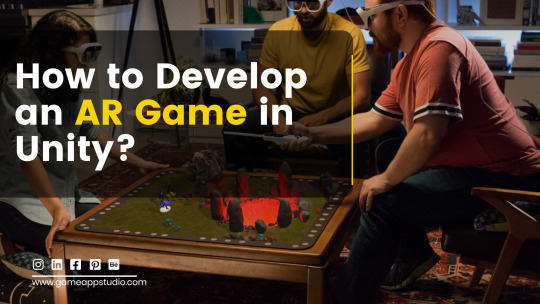
What is Augment Reality?
Augment reality is also spelled like AR. Basically, Augment Reality is another technology that is the enhanced version of the real physical world which is being achieved with some digital elements added to it. We Talked about games like Pokémon go. Where you will travel to your Neighbors to Find The Pokémon and add them to your Team for battle. AR is an experience where designers enhance parts of the users' physical world with some computer-generated inputs. For example, like if you brought the new sofa in the house and you want to see in which place of the house he would look good? So AR brings this functionality into the real world like visualizing your own furniture before placing it in homes.
What is unity?
While Developing the Games There is a 100% possibility to develop a Best Augment Reality game with the most Prominent Game Development Platform. Unity3d is the most popular and best game development engine that has the capability to develop a 2D & 3D game, Console Game, AR Game, VR Game, and Mobile Game.
If you haven't installed Unity yet click here
How is Unity Engine linked to AR with these potentials?
The untiy3d engine has the custom resources to bring your immersive experience of vision and bring them in the real life. While Developing the game Unity3d engine provides new tools and technologies like Unity Mars, AR Foundation, XR Toolkit, that help you to deeply and intelligently interact with the real world.
Tutorial to develop an AR game:
As the AR Games has some sort of different features than other games like players can access the game from different physical environments using machine vision detection surface detection methods. Well while you thinking about learning to develop a Game in Unity AR Solution there is a YouTube channel "Game App Studio Campus" where you know everything about Game and App Development of Android and iOS Games Now comes to your Tutorial, here is a simple strategy that will teach you the entire process of a simple process know the process about developing the AR Games:
1. Find Appropriate AR Games in the market: Before making the AR Game find out the different Top rated games in the market and how they become popular. What are the technologies they used there and how do you implement those topics in your own projects?
2. Become a learner: We should learn something amazing in our life daily, to keep arise the ability of learning and reading. So that's why YouTube is the right platform to learn everything. However, there is a YouTube Channel Name Game App Studio Campus that weekly updates Tutorials on Unity Engine and gives you the chance to meet their Professional Game Developers.
3. Get Directly to the Professionals: You can Contact the Professionals and meet them to check to take the key points. From all of it, You can also Contact Game app studio to meet our professional team hit Game App Studio in Google.
Final Verdict:
Finally, this tutorial provides you with a catch of sight on AR Solutions for the Development of the AR Game in Unity. Its Cross platforms integration, asset store integration, super visual quality provide you with the best AR Games with the new trends and much more of it.
Apart from the above AR Games functionalities like Unity also offers you the cross platforms games such as desktops, consoles, mobile, and much more.
Its pro version is the combination of multiple assets like a completely integrated environment, ready-to-use assets, intuitive processes and tools, a helpful community, and free video tutorials. However, if you don't have any time to develop the game so hire a professional for it. Game App Studio is the place where you find it.
Game App Studio is the leading game app development company that has a team of professionals that offers you the Full Cycle of Unity3d Game development services with the latest tools and tools and technologies like unity3d.
#Game App Studio#AR#Augment Reality#AR Games#Standard Ar game developers#Trends#AR game Development solutions#AR Solutions
0 notes
Text
A new immersive learning experience for the 21st century classroom

Shutterstock
We are transitioning from a world of passive technology to a world full of active learning experiences.
There is a wealth of opportunity for students to become creators of content, as opposed to simply consumers of content by using just a desktop, a laptop, or a powerful handheld device. The AR/VR industry continues to grow in its use and adoption in the way we work, socialize, learn, and entertain ourselves. Many AR/VR experiences pre-pandemic rested largely on the work of developers releasing apps, or one-off experiences that provide a limited glimpse into the learning potential.
Advances in these technologies are accelerating at a rapid pace, and remote learning has only hastened that process; open source developments in web technologies are now enabling any user to create their own virtual worlds and share those experiences with others. We have the opportunity to introduce these development platforms to students.
We’ve asked Anthony White, an educator in the remote island Kodiak, Alaska to share more about how he has built virtual worlds and experiences with his students.
How did you become involved with/interested in AR/VR technology?
As an educational technologist, I have helped teachers integrate technology into their practice, and have tested a wide assortment of effective tools for my own teaching purposes. But while I recognize that video technology can serve as a powerful medium for teaching and learning, I always felt like something was missing; I would teach on one side of the screen, while students passively received the signal on the other side. Even though I used computers in the classroom, many of the experiences were supplemental to a more traditional method of instruction. Despite working as an educational technologist, I had never before worked with 3D media and design.
Then the pandemic hit. While we learned to navigate this new reality, I embarked on a search for something that would truly capture my students’ interest, keep them engaged, and help enable a collaborative learning environment. In March of 2020 I discovered Hubs by Mozilla, a VR chat room designed for every device and browser. Hubs is an open source project that explores how communication in mixed reality can come to life.
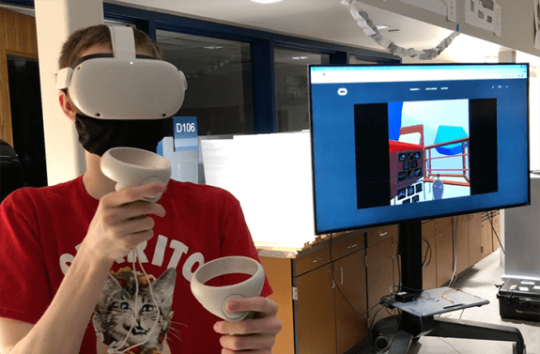
Painting in VR with OpenBrush
I knew this was the tool that would allow me and my students to take learning to the next level in the Digital Age, from scrolling for information to actually interacting with information. Dr. Keith Chan, Anthropology professor at the University of Missouri Columbia created an immersive learning environment that perfectly demonstrates this shift from searching to interacting with information.
How have you implemented Augmented Reality and Virtual Reality in your classroom?
We are in new territory in education, especially for secondary schools. My students have created a wide variety of immersive experiences, such as augmented reality experiences using the Reality Composer app for OS/iOS. My students have also created immersive VR experiences with A-Frame, a web framework for building virtual reality experiences. With this language and a brief primer on the structure of HTML, students can easily make WebVR with HTML and Entity-Components.

Students using FrameVR as a digital escape room
I also teach a course that focuses on workforce & internship readiness, helping prepare students for life after high school. For one project I helped students utilize Mozilla Hubs to act as avatars in a scenario where they could practice conflict resolution strategies in a safe and virtual environment. The results were astounding as some students chose to use Oculus Virtual Reality headsets to embody their persona. To see more of the amazing work our students are completing, check out this collection of students projects.
What has been the most challenging part of integrating AR/VR in your classroom?
The most challenging part in all of this is the fact that I am learning right along with the students. Though I would consider myself fairly adept at utilizing technology for teaching and learning, my knowledge in the syntax and structure of many of the languages that are the foundation of these experiences is lacking. I think it’s important that students know I do not have all the answers, but Github, YouTube videos, and documentation websites do. We learn, create novel representations of learning, and shape the future of education together.

Student testing out their AR creation
What’s next for your school and AR/VR implementation?
Next year I am very excited to offer a year-long course for Kodiak High School students titled “Interactive Media” in a new classroom called the “Innovative Media Lab.” Students will have access to a wide variety of new technologies and programs that will allow them to create virtual experiences spanning a variety of purposes. We will be helping to prepare students for a future that is deeply immersed in technology and interactivity.
In the fall we will also be hosting an international hackathon that provides a space for teachers and students to create immersive learning experiences that will be linked on a website called the Eduverse. The Eduverse is an amelioration of the metaverse, a collective virtual shared space, but specific to education. Any and all learners will be able to freely access these learning experiences as well as learn how to make their own and contribute to a growing collection of innovative educational technology.

Printing custom 3D game assets
What advice do you have for other educators who might be interested in AR/VR technology for their classrooms?
We are at the brink of something extremely exciting and new in Education Technology (EdTech), and to be honest there isn’t a whole lot out there (yet) in regards to student-generated augmented and virtual reality experiences. However, the tools exist and are in a constant state of development, many of which are open source and free to use. Take the time to learn with the students, allow for mistakes, celebrate the achievements and share them with the world.
A-Frame is a great entry point for many educators and students interested in building immersive environments. WebVR platforms such as FrameVR and Hubs by Mozilla are fantastic entry points for any learner and allow you to quickly create unique (and free) experiences. If you teach computer science classes, introduce your students to frameworks such as three.js or babylon.js. For instructors of game development, Unity and the Unreal Engine house a wealth of tutorials on how to create VR experiences.
Sites such as BrioVR and tools such as Reality Composer for Apple OS/iOS open up a world of creative possibilities to create augmented reality experiences (keep a keen eye out on Apple as something big is coming down the road that will most likely shape the way we view and utilize AR/VR). At this critical juncture in how we use technology, it is crucial we are providing students with the tools they need to be successful in the post-digital era. Let’s build the Eduverse together!
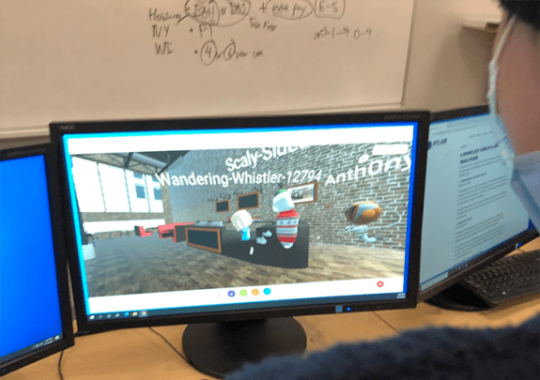
Using Hubs to manage conflict resolution
ABOUT THE AUTHOR
Anthony White is an educator of over 9 years currently teaching in Kodiak, Alaska. He is an artist at heart and always leans towards the creative expression of learning. Anthony is passionate about theatre, graphic design, traditional media, music, game design, and 3D modeling, especially when all facets of art intersect with computers and technology.
A new immersive learning experience for the 21st century classroom published first on https://premiumedusite.tumblr.com/rss
0 notes
Text
Studio III
Week 14 (June 11-16)
This week’s Update…
A list of “Good” things that happened:
Every day this week, we had spent all of our Studio time on painting the cubes. At first, I didn’t realise that painting would take up this amount of time, however, we were wrong. On Friday, we finally finished all of the painting process, and setup up all the cubes. Due to the time limit, I thought that we WOULD be and NEEDED to be finished everything by Monday, so we could deal with unexpected issues during the week, but now, I have no extra time to solve our problems, and it seems like we may not finish to the best of our abilities.

On Wednesday, Daniel and Kelsea came in with our Dyslexi-AR board. This is the base of our project, because it includes space for all the images cubes, the endings, and the letter cube, as well as displaying Instructions for use. The board was laser printed and laser engraves, which resulted in clean and smooth wood. I thought that board looked amazing and I was very happy with it, however, I didn’t have any input for it. Daniel and Kelsea made the decisions themselves. Now, the only thing left was to sand it a little, and paint the parts to label where each block sets. So, Daniel took up this job and completed painting on Friday as well.
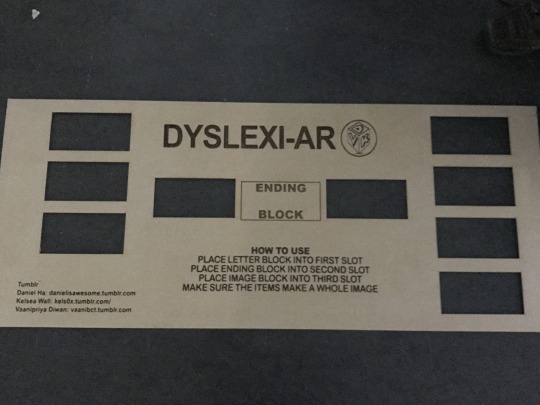

Due to the way Vuforia works, I needed to take the images of the “targets” for the software to detect. So, I needed all of the cubes finished (including 3 images cubes and 1 letters cube), as well as the endings, and the board. This is because the word order needs to be perfect for Vuforia to show the AR part. And after finishing everything else on Friday, I had the chance to take pictures to import it on to Vuforia. For this, Daniel helped me put all of the blocks in the correct order, so I could photograph the sequence on my phone. As soon as we finished the box, we delivered it to Kelsea, who was on ‘hinges’ duty.

On Saturday, Kelsea had finished connecting the box using clear and strong cello tape, in order to heat gun it, so that it would become like a clear plastic shine. She came in to studio to drop them off, so that we could finish our final setup.
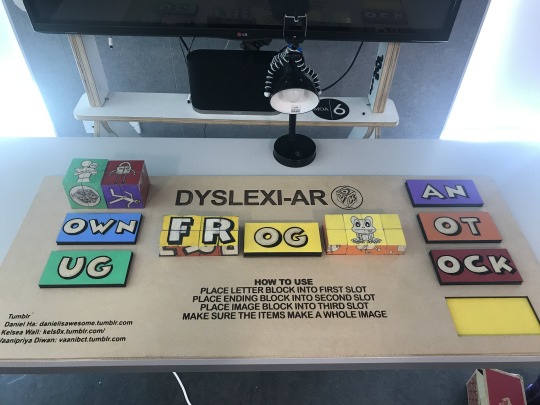
A list of “Bad” things that happened:
Since this is the last week before Submission on Monday, I am freaking out. Personally, I am feeling nervous about the overall project, and if it will work or not. I have been spending hours on Unity - Vuforia, in order to problem solve and look for ways for the camera to detect the target image, and then play the sound. However, it has not been an easy ride. I have probably watched 20 youtube tutorials and read over 10 websites, without finding the solution. This has been the lowlight of my overall experience of the Project, because doing the AR was my task, and I feel like I have let my team down immensely. I think that it will be “touch and go,” because it’s Sunday afternoon and I still haven’t solved the issue. I am looking at ways to change the code (C# script) and for it to detect the target images, however I have had to restart several times. Over the course of 3 days, I have restarted 4 times and spend hours trying to name each layer correctly, and adding the correct video to each target image. One of the biggest issues I faced was that I downloaded several different assets into a project, and that completely crashed it. So, I moved on and re-did the whole process, this time, sticking to the basics and following the guide. However, this is not as simple as it seems, because I have to import the photos to Vuforia each time, and down the databases, as well as set it up using appropriate layers and layer names. It is very time consuming.


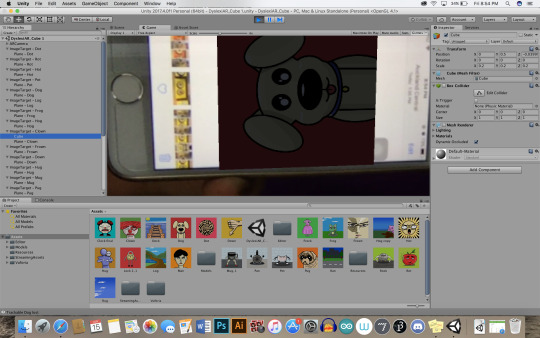
In terms of setting up, we finally claimed our spot on Thursday afternoon, which I think was a bit late. But, I pressured my team into arranging everything properly because I was getting extremely worried about not receiving a good spot, and also about leaving the set up to the last minute. This is because I really wanted to connect the TV with the laptop and position the table in its place, so that I could start testing the AR bit, as I need to ensure that the WebCam has enough distance from the table, for it to detect the Dyslexi-AR board.
At the moment, I think our set up looks average. In order to improve out foot traffic on the night of the Open Studio, I was hoping that we would have a Poster, a title, and a “classroom” like environment so that it relates to our theme. However, due to the time constraint, we were unable to discuss this further. Nonetheless, I designed the letters to be printed today, and printed them out in order to stick it at the top of our wall. This would definitely attract attention and also make our corner look a little more appealing.
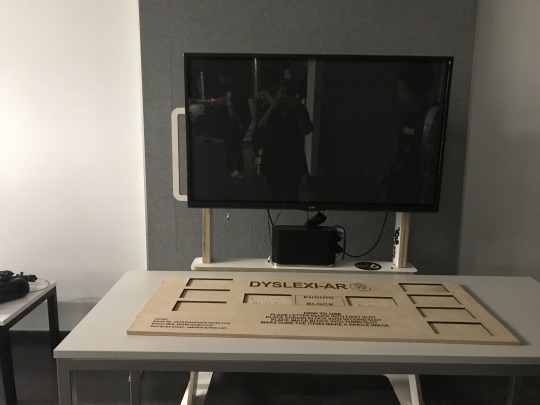
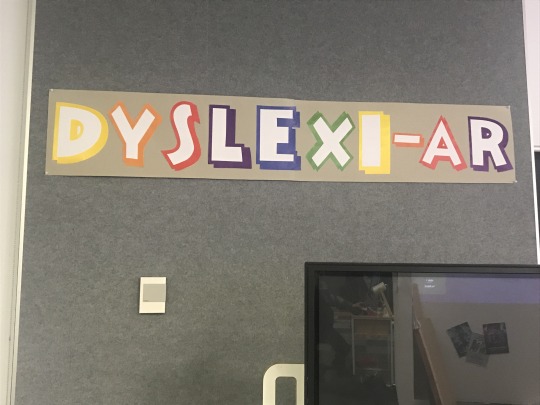
To top all of this off, I was unable to open Vuforia in the P-Labs, which we are using for the set up. Even though we were able to install Unity to the laptop, I needed to download more assets in oder for the Vuforia part of the Software to start. I asked Daniel to set up the software for me on Friday, since I was busy setting up the project in my laptop. He said that Unity was installed and left it at that, which cause this huge problem. When I came in to Studio to work on Saturday, I realised that I couldn’t set up because the P-Labs wouldn’t allow me to run Vuforia. It asked for the username and password of the admin, which apparently is AUTUNI, and needs one of the lecturers to sign in. So, this made me even more scared and crazy, because now, our set up isn’t complete, our AR part is not working and we are unable to meet up to resolve these issues.

———————————————————————————————————————————
2 notes
·
View notes
Text
Q&A with Camila Ventura, Zika Family Caregiver
Camila Ventura is a Brazilian retina specialist who is dedicated to understanding and fighting Congenital Zika syndrome (CZS). Camila’s work with Zika began during the 2015 outbreak in Brazil, when she first reported the ocular findings of three babies affected by the virus during pregnancy. We caught up with Camila to find out more about her past and current efforts to help babies and families affected by CZS. Camila spoke at TEDMED 2017, and you can watch her Talk here.
TEDMED: There has been considerable improvement in our understanding and treatment of Congenital Zika syndrome since the outbreak, especially thanks to the hard work of teams like yours. What are the biggest challenges communities affected by Zika face today?
Camila Ventura: We have certainly made progress not only in understanding the pathophysiology of this new disease and developing vaccines and tests to diagnose the Zika infection, but also learning how to care for children with Congenital Zika syndrome. As I mention in my Talk, it is impossible to care for a child with CZS without an engaged and interactive multidisciplinary team. We have learned that communication between different professionals is essential to plan interventions and potentialize therapies. We have also learned that CZS has a broad spectrum and that there is not a “one recipe” treatment for these children. In other words, treatment cannot be generalized.
We still face many challenges indeed. Our biggest challenge nowadays is getting these families to reach our rehab center at the Altino Ventura Foundation located in Recife, the capital of Pernambuco state. Most of the children are instructed to come weekly for therapies, but because many live in the countryside, dropouts are one of our biggest challenges.
Another important concern is the late complications that some of the children develop. We had at least 15 children who developed hydrocephaly and required a shunt. Despite the fact that the shunt surgery normalized the brain pressure, some of them progressed with vision loss. We also have children with different levels of dysphagia (some requiring gastrostomy). The biggest concern with regard to dysphagia is the risk of aspirating food into the lungs and developing pneumonia. We had 5 cases that died from pneumonia. The last, but not less important, challenge is the uncontrolled and severe seizures that some children present. Seizures bring a lot of concern not only to doctors, but also to families that many times feel impotent and helpless. However, despite all the complications and challenges we are facing, we are very proud of our work with these kids and their families. We now have three of them walking!
TM: What projects and research have you been involved in since you spoke at TEDMED 2017?
CV: Since TEDMED, we received a National Institutes of Health (NIH) grant and started a collaborative research study with the RTI International, a well-known and respected research non-profit organization. The main goal of this study is to follow 200 children with congenital Zika syndrome and their families for a period of 5 years. By assessing each child, we are trying to understand important outcomes such as neurodevelopment (motor skills and cognition), functional skills (activity of daily living, feeding, and sleeping), social and language skills, temperament, and behavior. Another aim of this study is to understand how families have coped with this new challenge and adapted to disability by assessing stress level, family dynamics, and social support. We hope that this study will enable us to provide an optimized habilitation treatment once we identify specific delays in the child’s development and at the same time, provide caregivers with psychological and social support by understanding their specific needs.
P.S.: I gave an interview at RetinaLink after TEDMED and the NIH Grant.
TM: Your team is composed of a multidisciplinary group of specialists, each skilled at addressing one of the many systems affected in babies with Congenital Zika syndrome. What were some of the challenges in bringing doctors of different backgrounds together? Were there any surprising or unexpected outcomes that came as a result of the collaboration?
CV: To answer your question, I need to explain about our history. The Altino Ventura Foundation is a non-profit organization that started in 1986 as an eye center for the low-income population. In 2004, we opened our Rehabilitation Center that used to be run in a small rented house and we were only accredited to perform visual and motor rehabilitations. However, in 2014, we finally moved to a 3-story building owned by us, and that was when we became fully accredited to rehabilitate patients with multiple disabilities in all four domains (visual, hearing, motor, and intellectual).
By then, we already had the different physicians and therapists working at the same place working for the same goals. Also, at the FAV we have always valued teamwork and interaction between our professionals. However, with the advent of Zika, the interaction was intensified, which brought more unity to our work. Thanks to this strong connection, we have been able to see how it has positively affected our children’s outcomes.
Another important aspect that Zika brought to our institution was the possibility of developing our own protocols for Zika. Since we have the oldest patients with Zika, we did not get to learn from others how to treat our patients. Zika empowered us to develop our own protocols that are used today to treat our children. The visual impairment assessment protocol, for example, was developed by our team and published in the Journal of the American Association of Pediatrics (JAAPOS) in 2016 with the intent of sharing with the world what we have learned so far about the visual aspect of CZS. In addition, the FAV has been a hive for other professionals from other states in Brazil and from the US to visit and to be trained for CZS habilitation treatment.
TM: You work closely with the families of babies affected by Congenital Zika syndrome, and you mention in your Talk that you consider mothers and caregivers to be your best allies in the treatment of their children. When a family is empowered to be involved in treatment, what sorts of positive results do you see?
CV: I truly believe that families make a difference in the child’s outcome not only for children with Zika, but for every child that needs close assistance. In 2016, we realized just how slow the response to our early intervention therapy was—children were coming once every week to the FAV Rehab Center, and we had to think of different strategies since we could not provide as many assessments as we would have liked due to Brazil’s economic and financial situation. We basically had to work with what he had. Despite teaching mothers/caregivers how to stimulate their child at home, we knew they weren’t able to purchase the toys or equipment that were necessary to do so. We then came up with the idea of handcrafting a multi-sensory kit with the mothers/caregivers. They have been using the multi-sensory kit since then and we have filmed a tutorial of how to use the kit and uploaded the series to YouTube so other families can learn and benefit from this idea as well. Here are our tutorials divided into parts 1, 2, and 3. We also provided mothers/caregivers with constant workshops to empower them because we know now that committed parents/caregivers can change a child’s overall outcome.
TM: What was the TEDMED experience like for you?
CV: Absolutely surreal! It was the most thrilling, exciting, scary, nerve-wracking, and challenging experience I ever lived. Having to memorize my 15-minute talk in English and deliver it with emotion with all the tension that was going on inside me was not easy. But after succeeding and looking back at the entire preparation process, I can only thank the amazing professionals I got the chance to work with since day one. I appreciate the sweetness and patience of Lucy Barry, the great suggestions from the straight-to-the-point Marcus Webb, and the amazing support I received from Shirley Bergin. I could not ask for a better team! And if I can add, now that I have stepped in the TEDMED shoes, I value even more each and every speaker that gets on stage to share their personal and/or professional experience – we all have walked an extra mile! Thank you TEDMED for such an amazing experience!
The post Q&A with Camila Ventura, Zika Family Caregiver appeared first on TEDMED Blog.
Read more from TEDMED https://blog.tedmed.com/qa-with-camila-ventura-zika-family-caregiver/#utm_source=rss&utm_medium=rss
2 notes
·
View notes
Text
How we make games - about workflow, things from the past and lessons we learned
I like to seperate the games we make into two categories: Game Jam games and actual™ games. For those of you who might not be familiar with the term – a Game Jam is basically an event where people make a game in a very short amount of time, like two days just for example. In most cases there‘s also a given theme the game should (but must not) match. But that‘s not the kind of stuff I want to talk about today, let‘s save that for another post (we participated in three jams last month so I have a lot to recount :‘D) Let‘s focus on the latter – the actual™ games. We‘ve made two so far. Intra-System: Trust Issues, our very first game, and Flufftopia. When it comes to the work process these two have nothing in common though. That‘s because we were a three person team when working on Intra-System. Not long after we started working on the next project (which was Devastated: Andrew‘s Dictaphone) we parted ways with our former programmer due to some personal stuff. Also Devastated was meant to be a completely different game at that point, but I‘ll save that for another post too (damn, while writing this I get so many ideas for future posts :‘D). And at that point we decided to put Devastated on ice because we needed to restructure the team. I only made the graphical stuff for Intra-System and Daniel wrote the story, made music/sounds and coordinated the overall workflow. We decided to stay a two person team and not search for a new programmer simply because we realized that doing everything on our own seemed to work best for us. We also wanted to be as independent as possible. Well, that meant that one of us needed to start learning something programming related though.
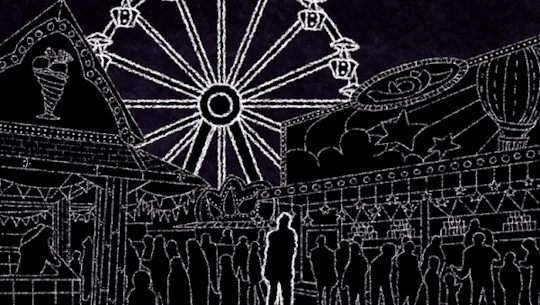
At that point I sat down and basically spent two months doing nothing else but gathering as much knowledge as possible about the Unity engine. We decided to pick Unity for various reasons: 1. Real™ programming, a framework etc. wasn‘t an option because I had no programming background at all and it would have taken too long to learn that much. We wanted to be able to continue with games ASAP. 2. We were mostly focusing on 2D games at that point and Unity seemed to provide everything we needed. We of course could also have chosen a more 2D focused engine like GameMaker or RPG Maker but we wanted something that was capable of 3D too because we knew we would want to make 3D stuff in the future and learning different engines for both seemed redundant. 3. Unity‘s pricing policy was the one we most likely could live with. So that’s why we didn’t end up using Unreal and whatnot. So yeah, I made a very small very shitty clicker/idle/incremental game (why are there so many names for these?) in the learning process which really isn‘t worth talking about. Let‘s just say that Daniel was bald at that time and I took this as a theme for the game. The game is completely in German though because I didn‘t think that I would ever show it to more than 10 people.

And around that time we came up with the idea for Flufftopia. We really enjoy experimenting with existing genres so we thought of ways to mess with the clicker game thing a bit. Eventually Daniel came up with the basic idea for the story and the twist. I don‘t want to tell too much because it would take off a lot of the experience – you can check it out yourself if you want to. It‘s free and should only take you 20-40 minutes. The first thing I wanted to have was an artstyle. When talking about the idea I imagined something supercute and I think I didn‘t fail that too hard. First of all I drew a background to get an overall feeling of the direction I wanted it to take. At that point I didn‘t really know where the background would eventually end up. Now it‘s the main menu.
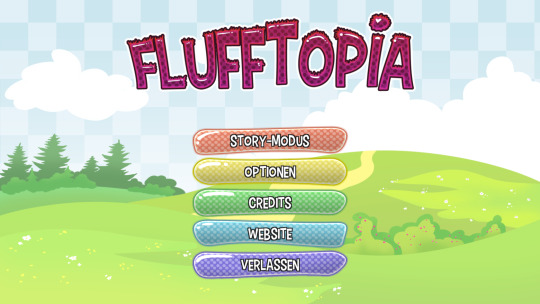
The designs for the unlockable buildings and the basic idea for the Fluffs, the residents of Flufftown (I still love how fluffy all of this sounds ♥) followed.
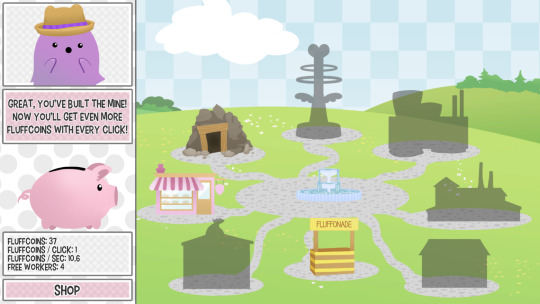
After that I felt all of the fluffiness deep in my heart and was ready to start putting things together. Fortunately I was able to reuse some code from the first clicker game thing so I had some basic stuff going on pretty fast. But then we started putting in the story aspects and more features… and that‘s when everything started to go south. Let me tell you one thing: simply following tutorials and trying to figure stuff out on your own are two very different animals. Especially if you basically don‘t have a clue of what you are doing there.
It‘s working! But why? It‘s not working! BUT WHY?!
I‘m glad that I don‘t have that struggle that often anymore. I still do, but I sometimes think I know what the problem is. I‘m wrong most of the time, but that‘s how learning works I guess. Also: Another reason for choosing Unity! The community is huge and it‘s very likely that someone has had a problem you are having right now before. There are thousands of entries in the forums and up until now I always found something that could help me out. Back to Flufftopia. I really like to run off the track. We managed to finish it somehow. The last weeks before release were pretty tough though. We needed to delay the release and cut many things we initially wanted to have in the game. A save system for example. And a second game mode. And much more. I simply wasn‘t capable of these things at the time. Especially in the short amount of time we had left. Lesson learned: Try not to bite off more than you can chew. You most likely will anyways, but at least try not to. But nevertheless the feedback we got for the game was unexpectedly positive – with over 3000 downloads it was our most successful game up until now. We also definitely want to make a large update somewhen in the future to hand in all the stuff we wanted to be in the game later. If you want to know even more details about the development and release, I recommend you to read this article Daniel wrote some time ago. Is the stuff I‘m telling you even interesting? I don‘t know. But that‘s it for Flufftopia. There‘s one more thing I‘d like to talk about in this post. When people ask what our specific tasks are we often answer with something like „Angela does art and programming and Daniel does the rest.“ And that often seems to confuse people. They assume that it’s me who‘s doing all the work. And that‘s absolutely not the case. First of all – Daniel is the idea guy. I wouldn‘t consider myself a creative person when it comes to coming up with game ideas, concepts and stories. I like being creative in graphical art for example but I need a base to work with. Also sound is something that shouldn‘t be underestimated. Many people don‘t realize how much of the atmosphere rises and falls with sound. And even though I kind of make music from time to time (up until now I made the title track for Flufftopia and that‘s it X‘D) it‘s mostly Daniel who‘s taking care of these things. Also he‘s the one coordinating everything. And when I say everything I mean everything. I‘m a total disaster when it comes to anything related to organization. So yeah, that‘s something he‘s taking care of too. All day. Every day. Thank you, Daniel. He also started to learn 3D modeling because that‘s of course something you need when making 3D games. And he‘s doing pretty well. And I‘m pretty thankful for that because I wanted to learn using Blender once and I rage quitted because it‘s… well, let‘s just say it‘s a very special program and I can be a very impatient person sometimes. So Daniel started making sinks and toilets for some reason. But hey, I think they look pretty cool!
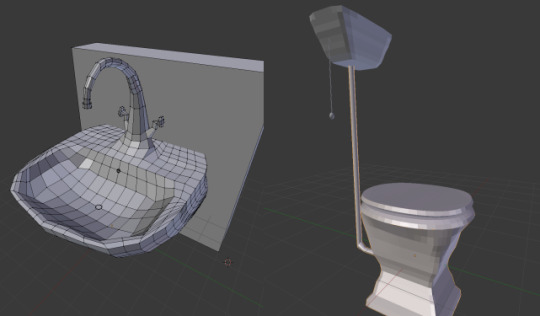
And then there‘s also marketing and PR of course. And all the other stuff I don‘t want to take care of. And he makes amazing coffee!
2 notes
·
View notes
Text
Finalising my 2nd year: Statement
In my assignment submission for the 1st semester I hoped that I will acquire the following knowledge and skillsets:
Expanding my portfolio: I have created new contents of a music video, a tutorial video, a sound design showreel, and I am currently working on my electronic music album.
Becoming a better audio implementation programmer: during the making of the Unity + Wwise audio implementation video and the procedural audio module works, I have been using C# programming language and have learnt new techniques to implement audio in a game. I also successfully finished the Wwise middleware’s 101 and 201 courses which made me become a certified audio implementer. I also had the opportunity to work on the audio of a brand new e-comic book (as part of the dBs Productions team) where I was the lead audio implementer and assistant producer / sound designer. The developers of the e-comic book were very satisfied with my work and knowledge, and requested a ‘How could we improve our audio engine’ document from me, which I have gladly prepared for them. The company will probably get in touch for further works.
Improving my sound design skills by creating and releasing a modern avant-garde EP: unfortunately, I haven’t had time to finish this EP, however, I have finished two songs so far, and I am currently working on the rest of them. The building of these tracks seem to be a slower progress compared to my previous songs, as I am going in deep experimentations with modular and granular synthesis that needs more time to record, select, and arrange them. This EP creation idea was my plan B, for the case if my job applications fail to succeed.
Continuing to create more connections by going on events and participating on game jams, and start selling my music and sounds using online platforms: I attended on the global game jam in January, which was a bit risky because of my recent operation on my right ear. It turned out that I was just over-panicking the situation and I managed to write 5 songs (4 level and 1 menu music) within the first day. I spent the second day creating sound effects and implementing the sounds using Wwise. I have learnt very important communication skills on this game jam. I also approached the Publishing Director of BuildBox which is an aspiring game engine that doesn’t require programming knowledge, to find out more about their audio system.
I also posted an advertisement into multiple film and animation groups, offering my music composition on people’s video. I have been contacted by a 3rd year university student who needed music to her interrogation scene, which I finished on time and she was very happy with the result. There is also another video project in which I need to compose music for an office argument scene, which I’ve promised to do after the assignments.
I also found out how I can sell my sound effects and music on the Unity Asset store and Bandcamp, however, both websites need artwork for the uploaded music, and I found it difficult to find or create artworks that are free of copyrights, so I had to delay this step. I attended on the quarter Game Audio South West meetup, where I’ve met some new faces. I also attended on a Unity online meetup in April, where a funny new co-op game ‘PHOGS!’ was introduced. I asked audio related questions and made sure to make a memorable introduction to the participants, so hopefully next time when I appear on a Unity meeting they will remember me.
Working on getting my first paid (possibly game) audio job or internship: Although the e-comic job was unpaid as it was more of an ‘academic research’ project, given the fact that the developers were extremely satisfied with the results we provided and my relentless work for the tight deadline, I trust that they will be in touch as soon as they have a new comic book in the works, that they need music for.
I am participating in another team, which is an Augmented Reality project for the Exeter Library. I am the audio implementer and I will use Wwise to implement sounds into the Unity AR project. This is a paid project.
Job and project description - i.e.: Illustrations of the kind of work carried out, analysis of what you learnt:
Rip-pair game: I have learnt that the stuff we discuss and agree in the beginning of a game jam, is very very important for everyone to follow and stick to. If someone doesn’t do as it was agreed, it can ruin the whole game feel and aesthetics, as there is only 48 hours to get the game done, so there is no time for correction works and revisits. To ensure everyone is on the same page, small check points can be set up throughout the game creation, where everyone showcases the work they have done so far on the project. On these meetings (and generally on a game jam) using technical words and jargons are not recommended, as these can lead to misunderstandings/misinterpretations of the common goal.
Sound Design Showreel: I did not need to learn anything new to deliver the sound design video, although I did lots of preparation works before starting working on this video. The plenty pre-recorded sound libraries I made became very useful as there were only a few additional sounds that I needed to record to complete the work. However, after sending the video to a professional sound designer (who currently works on the new Halo game in Los Angeles, California) who very kindly reviewed my video and provided a long and detailed review, I have learnt a lot. He told me to be careful about using low frequencies for sound effects that can be triggered frequently. He raised my attention on using more cloth/leather/denim sounds especially for jumping and crouching movements. He also pointed out the lack of footstep weighting, which needs to be considered depending on the character’s bodyweight and walking / running speed, and not just the floor surface. Sound effects in a fight scene can be overwhelming, thus the player is not expected to hear every sound in a fight. More focus needed on the sound when a combo kicks in, or when the character is famous of having that particular weapon, then the weapon is super important to have an amazing sound. (eg.: Kratos and his axe + shield in God of War). He suggested to take a step back and find the small but really important moments, and analyse them under a “magnifying glass”. Think of transients (how sharp a sound should be), frequency range, sound to be tight or loose, using single or double transient and materials/textures of a sound. Since he raised my attention to these details, I’ve been playing games on headphones and focused on the sound design very carefully. I strongly believe, that the more and different type of games I play, the more focused and analytical my hearing will become.
Sherlock Holmes e-comic book: My learning in this project was more about the experiencing of how does it feel to be in a team. I have learnt that it is extremely important to set out the job expectations and responsibilities prior the work has started, so one can avoid inconvenient situations, heavy workload and awkward meeting moments. I learnt that I have to be able to say stop for additional ‘favour’ work, and only do further work, for something in return. That doesn’t need to be money. I have also learnt that it is wise for the manager or leader of the team to have a short catch up session with the members of the team individually once the work is done, to find out how they felt, whether they have any feedback or issue they want to raise. This can help avoiding awkward meeting situations and is definitely helpful to keep the team members happy and informed.
Interrogation Scene project: I have learnt that people can deliberately provide you misleading information about their project, just to convince you to work on it. Especially, when you offer your services for free. The 3rd year uni student also asked me to write music for further scenes in her project, but I politely refused to do so, as it was not part of our initial agreement, and I can only do further works for an acceptable fee. This was the moment when I used the lesson I have learnt from a similar previous situation, to be able to say no for someone who (obviously) doesn’t appreciate my service enough to pay for it. I only spent about 6-7 hours composing the music for her interrogation scene, as it wasn’t in the dark-electronic style we agreed beforehand, and her careless attitude started to really annoy me. After sending her the finalised composition which she was extremely happy with, she asked me what kind of scene I was looking for, because she might be able to find something in her files. I politely closed the conversation, as my experience with her didn’t really go as planned, which led me not to trust in her anymore, as well as the quality of the video she provided wasn’t the type of video I was looking for to work on. In this project, I basically learned how to say no, and how to avoid unreliable people.
0 notes
Text
Off Grid Development blog 8.11.2017 - Changing Times!
The times-they-are-a-changin.’ New horizons, a shake up, big things happening - this has been a heck of a sprint!
Blocktober
Completely unaware of our social media surroundings, Rich managed to spend a good portion of this sprint during October whiteboxing and completely miss the whiteboxing trend on Twitter that was #Blocktober! Nothing nearly as fancy as the timelapsed art passes from the Naughtly Dog team on how they constructed key hero sequences in the latest Uncharted, but we do have a new building for the intro scene in the player’s apartment. If you haven’t seen this yet at a demo I won’t give away any spoilers, but this level is where your hacking journey begins!
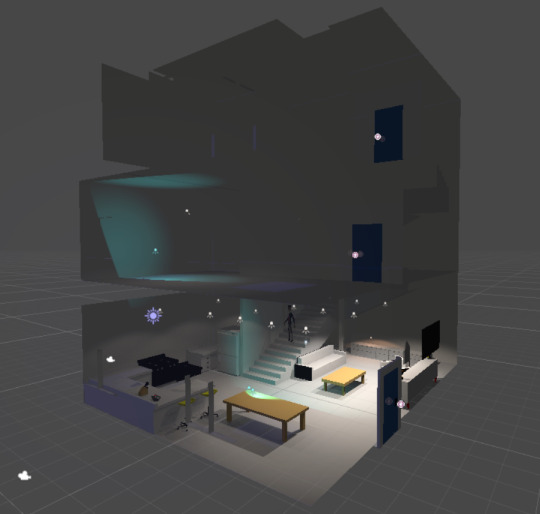
Indies Unplayed
We were extremely fortunate to be asked along to Indies Unplayed at Secret Weapon Loading Bar in Stratford. It’s always great to show the game and get player feedback. Many thanks to Lauren Francis for having us along, it was a very cool little event and we had some really inspiring titles along side us. Below you can see a player learning the setup to our hero’s story in the intro cutscene we are currently making playable.
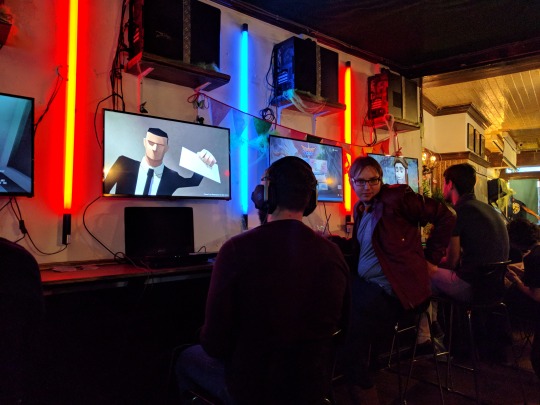
We got to play some fun new indie games and catch up with some old friends too, including old chum Tim Constant, who we last saw at Nottingham Gamecity in 2013!!!
Tim is working on a very cool dystopian job sim. It’s a #PapersPlease-like game, where you play an immigrant bouncer in a post-Brexit apocalypse:

‘Settings’ it up
It’s been quite short and quick sprint, so there are no new amazing game features to talk about from Pontus. But as promised, our settings system has now evolved from a bunch of background systems and code into an actual menu. With some actual settings you can adjust!
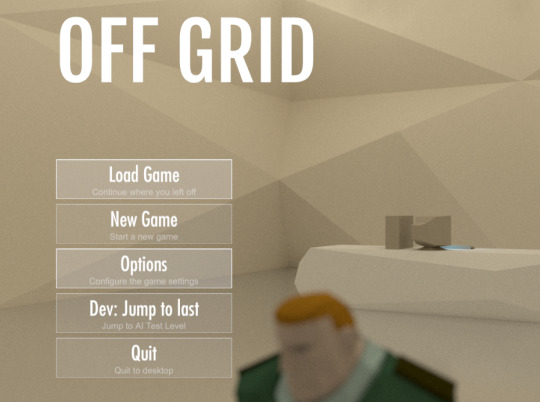
The graphics will definitely need more work, but the plan is to fill in more options and then do a second pass on the artwork and layout to make sure everything works well with the content. For now, everything is functional at least.
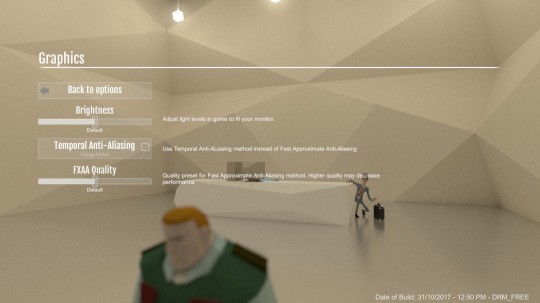
Web work
Apart from that, things were polished up in the web side, with some imrpovements and additions to our wiki and to automate our newsletter. That’s going to make our life easier, and hopefully also help any players/modders to find the right Lua API and instructions for how to set things up in LevelKit in the future. I would say “go and check it out” but there’s not really much interesting things in the wiki yet, at least unless you are one of the lucky ones who have access to our builds and the LevelKit already. In which case, you of course should go and check it out to get you started testing how to create your own content for the game!
No funny bugs fixed by Pontus this sprint, and no interesting game design work either. But there definitely will be next time, he’s already spent the past few days with XMind open for plotting some pretty big changes for the game…
Mod testing
This sprint Josh, our modding and level design intern, challenged himself to build a level using the modding tools. The aim was to learn how to build a typical level with a focus on the Lua scripting side of things rather than art, and then take those learnings and see where he could fill in the gaps on the wiki that he found wanting.

We’ll let him tell you a bit more himself though:
“So I started out by blocking out the map that I wanted to create. Once I had the basic level that I was happy with I got stuck in with the Lua scripting with which I managed to learn a great deal upon completion of the level.
One of my favourite parts of creating the mod was the conversations, as it was super simple to create but also great fun generating branching dialogue between characters. Following this, I began work on a guide to building a level mod which has been added to the wiki.This is something that I felt would be important for potential modders to have to help make the modding experience more accessible.
This also resulted in a few new pages being created to explain some sections not covered on the wiki yet, such as the ability to add characters to your level. This is a very exciting and interesting feature which will allow you to create many gameplay elements, from conversations to patrolling guards.
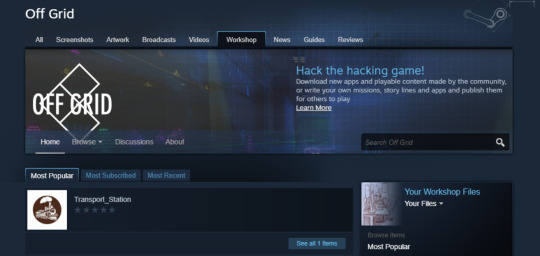
I also had the pleasure of testing the new ability to upload mods to the steam workshop using the Level-kit tools.
Shortly after that it was decided that we should create a mod level that people can download that would demonstrate some of the pre-made devices that any modder can essentially drag and drop into their own mod. It will also be playable which I will turn into an interactive tutorial of how these devices were made to help new modders create their own from scratch.��
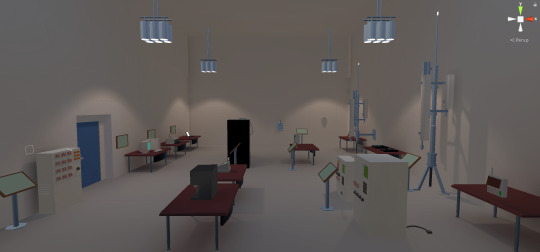
Farewell Harry
Harry had his last sprint with us this month as he is moving to join the development team at Unity, but we made sure he had time to part with a gift for any of our followers who are devs interested in making their games moddable too.
In his time on the team, Harry's done great work pushing modding in Unity 3d, and so we’ve open sourced his work on the Lua framework that makes Off Grid moddable, enjoy!
https://github.com/Semaeopus/Unity-Lua
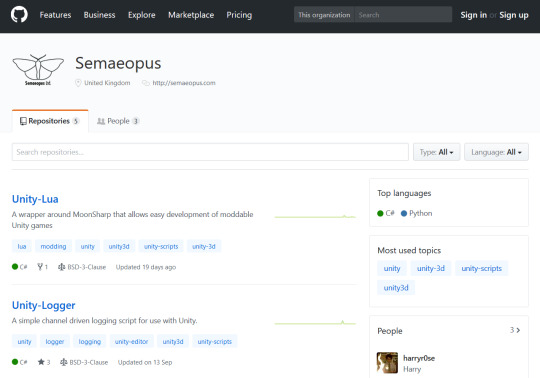
Out with the New in with the Old ;)
And with our youngest team member Harry heading to Unity we have gained the wonderful Steve Allen in his place. Steve comes with a bundle of AAA and Indie experience, so much so that he qualifies for ‘industry veteran’ status, and we are pumped to have him aboard the good ship Semaeopus. I’ll stop rambling and let him introduce himself though:
Hello! I’m new here. I’ve joined the Off Grid team as a programmer, though will no doubt stick my nose in elsewhere. I’ve been programming games for, well, rather a long time, and am really excited to be part of the project. There’s lots of interesting stuff that still needs to be done and it’s already been a welcome change from the larger, corporate games I’ve been working on over the last few years. And who knows, next time I write one of these updates I might have done some work! - Steve
You’ll hear a lot more from Steve in the coming sprints, he’s already made good strides into impletmenting and extending new features in the Lua API for modders to play with, so watch this space!
Fixes and additions
Harry’s last couple of weeks were also a great opportunity for us to dig into some of the bugs in our backlog that haven’t been top priority, but would be welcome fixes with a little effort. We had a fantastic flurry of small fixes from the team, with Harry leading the charge.
Main game:
Messaging with CryptoChat
We setup a small notification to say that a character is typeing while you are waiting for them to respond to you in a conversation. It’s essentially a ‘Smedley is typing’ animation much like you’d see when using a messaging app like whatsapp or imessage.
We also and fixed the pause time between messages, which just needed a little finessing to feel more real.
And most importantly, we set up ‘B’ to skip single messages instead of all of the incoming messages from another character.
Include Mods in use, in save games
We now have save games recording what mods you have subsribed to so you can progress with your mods intact!
Saving NFC
NFC data is now being saved correctly.
Trailer video
We fixed a strange long wait at the end of our trailer that had been bugging us.
Player Phone
We fixed a bug to do with interactions when the player phone didn't appear when doing swipe interaction or scanning things.
Stuck Running
We had a somewhat funny but awkward bug in our animation state machine where the player can get stuck if you were crawling and spammed the run button while getting up - the player would get stuck runnning in circles! That is now fixed ;)
Look around you
The player character’s look-at IK needed more restriction on target height so that you didnt look at interesting objects on the floors above or below you.
Invisible walls and soft bathroom sinks
Lots of missing colliders were fixed.
LevelKit:
UV Warning
We updated asset importer post processing script to warn about missing normals and UVs on new models. This means as you are modding and making new geometry, the LevelKit tool will tell you if it is missing anything that could cause a later error.
Mod Content structure
We re-structured level directories so that the content a modder makes is in a neater structure.
Non Steam works / DRM free mod exports
Added Export as Zip option to build tab so that you can upload your mod anywhere for anyone (with a copy of the game) to try it out.
That’s all folks
Lots of big things happening so we’ll look forward to catching you next time.
Pontus, Rich, Sarah, Steve & Josh
#offgridthegame#stealthgame#hackinggame#moddablegame#modding#moddable#modded games#dataisyourmostpowerfulweapon#data privacy#infosec#github#unity#madewithunity#Unity3D#steamworkshop#steam games#Lua#videogame#video games#gamedev#indiegames#indiedev#indiegamedev#Indiegame#indiesunplayed#loadingbar#semaeopus#game design#game settings#blocktober
1 note
·
View note
Photo

I HEART WORK
Who are you: Luisa Brimble
What is your work: Photographer
Where can we find you? Website | Twitter | Instagram
Describe your work in 5 words? I’m a lifestyle and food photographer - that’s more than five words!
Can you tell us a little about what you do? I photograph food and lifestyle stories - my favourite subject to shoot is food in context, and product in a lifestyle context.

What took you on the road to being a photographer? I picked up my first DSLR which is the Canon 400D and just started taking photos. Then when family and friends started saying I could do it for money, I started to take it seriously and taught myself how to shoot manual, bought a load of books, and watched a lot of tutorials. I only attended one photography workshop and it was with one of my favourite photographers – Jonathan Canlas, a film photographer.
Where is your office/studio and what is the view out of your window? I work from home and it’s pretty uninspiring view of the neighbour’s house!
What is the first thing you do when you get to work? Meet the team, talk to the client whilst I’m unpacking and setting up, and work out what the strategy is for the shoot.

Describe a typical day at work? If it’s a shoot day, then I wake up early, get my girls ready for school, drop them at school, drive to where I need to be for the photoshoot, photograph the whole day and in the afternoon pick up my girls at school, go home, upload photos, edit and deliver to client, BOOMPOW done! Then the rest of the time frees up to study, analyse and scheme-up the next story I’m shooting with Sarah Glover - a week doesn’t go by without photographing.
What cameras do you like to use? A Canon 5D mk3, and 50mm 1.2 lens – my go-to-lens, and never leaves my camera, I’d say 94% of the time.
What can’t you work without? My family’s support. Without it I don’t think I’ll have the luxury to be doing what I’m doing now.

Why do you love what you do? Passion fuels what I love to do! Because if I believe in a project but there’s no money to it, I will still photograph it. I believe that if it’s beautiful and different enough, chances are I’d be lining up to shoot it.
One shoot you won’t forget and why? Not just one shoot it is all of WILD Adventure Cookbook with Sarah Glover. Every scene created and photographed was full of life, new experience and it gave us the burst of energy to keep on going. It was like we were so inspired by the last shoot that we just kept going for 2 years. None of the recipes from the book was photographed indoors. It was all outdoors.
Who or what inspires you? Right now it’s all about Dynamic Symmetry and I’m seeing works of art in a different way. In a way that gave meaning to how I felt when I first laid eyes on a painting or a photo. It gave me the answer to the why. Right now the work of Henri Cartier-Bresson and Vivian Maier is really inspiring me to keep on studying and analysing art and photography.

What is the best advice you have received? One is better than nothing.
One moment in your career you will always remember? When WILD cookbook got funded via Kickstarter.
What is the best part of your job? I get to photograph what I’m passionate about, and because of this it gives me the opportunity to see parts of the world I thought I’d never see or experience.

And the worst? The selling unfortunately...I still have to work at finding work.
Which phrase do you overuse? ‘FREAKKIN BOOMPOW’! Because when I talk about something that’s passionate, I will give it to you with gusto!
What have you learned the hard way? Not knowing about Dynamic Symmetry. That I spent nine years photographing based on my feelings, and I never knew how to analyse or study works of art. It was frustrating. It was a question hanging around waiting to be answered. It was answered about a month ago now, when I was just watching YouTube videos and I came across Myron Barnstone’s film about ‘What is Dynamic Symmetry’, and it clicked! Since then I’ve been sharing my learnings via Instagram Stories. I share my analysis of works. It disappears in 24 hours. You have to be quick and you have to be paying attention. People who pay attention are the ones who get rewarded!

If you could do another job what would you like to do and why? I would probably go back to doing Graphic Design. I used to work in Marketing, creating all the collaterals, flyers and advertising in-house for a travel company. I did that for 10 years and I really did enjoy it. I would probably do something along these lines of multimedia.
What advice would you give to someone wanting to be a photographer? There are three stages in your photographic adventure:
1) You will spend your time learning how to press the buttons on your camera. Learn where to change your aperture, ISO, your shutter speed and your metering. It took me maybe two-three years to be better at this, and then it became second nature to me.
2) You will then be rewarded with being able to be creative in what you do. You can start to emulate the works of the photographers who inspire you. I’d say give yourself another three years to get better at this.
3) You discover that there is such a thing as Dynamic Symmetry and you spend your time studying it and analysing people’s work etc. Give yourself seven years to put this in practice.
4) BOOMPOW! If you actually practice and shoot on a daily basis say two hours a day, in 13 years time you have reached your 10,000 hours in becoming a master in what you do! You have to be in this for a long run!
Photography is not about just photographing pretty pictures and all you do is press the shutter. It’s all about designing your frame. Slow down before you press that shutter. Don’t just look at your subject, look at the background and what elements of design can you incorporate to make that image have the order, unity, harmony, movement and rhythm. Shoot, shoot, shoot and shoot and study, study, study, study!

Can you tell us about your new book WILD with Sarah Glover? WILD Adventure Cookbook is the collaborative cookbook project that I worked on with Sarah Glover. It was shot over two years at 17 locations along Australia’s East coast. This cookbook pushes boundaries wherever it finds them and it’s taking outdoor cooking to the next level. WILD is about breaking rules and challenging conventions. I believe that magic happens when food is photographed unadorned and uninterrupted. It may have taken us two years to photograph this book, but we would not have done it any other way. The desire to be different, to go against the grain, to push boundaries, create new work, instead of replicating what’s out there, is what connected Sarah and I to create this cookbook. This book is photographed ‘documentary style’ – out in the wild, completely free of studio and conventional kitchen. I was there every step of the way, capturing the moment; the ingredients, the processes, the locations, the people, the drama and the absolute magic that occurs when these elements all come together. I feel that photographing food in context gives it soul, which gives this project its point of difference. In a perfect world, I hope to photograph all future cookbooks in this style.

Can you tell us about any other projects you have in the pipeline? Currently WILD #2 is in motion, and we already have plans to travel throughout the year and at the same time going on roadshows to promote WILD #1. It really just depends on what opportunities come out of this, we just don’t know, but we have to keep going on the project because WILD #2 is beginning to show some ‘legs’, it’s in motion!
Do you have any favourite websites/Instagrams you can share? There are only two websites I will recommend for keen foodies who want to learn more about the in’s and out’s of food, and more importantly learn about history. The first one is Art of Eating, and the second one is Ideas in Food. Food blogs these days all become about a form of self expression, pretty pictures which are highly styled - it is now all about the styling and not about the food anymore, it’s all about yummy, beautiful, amazing, incredible blah blah blah… I feel that people are going to be wanting more. The blogs who will stay are the ones that give value and educate people.
How do you spend your downtime? My downtime is spent studying, improving my muscle memory so that I can practice learning about the elements of design. I spend it reading and analysing. Listening to podcasts and getting all psyched up! Or if I get sick of doing this I’d probably be cooking!

Can you give us a great tip on how to take better photographs? Yes, Google Dynamic Symmetry. Start with Myron Barnstone. Start watching his YouTube films.
What would you like to be doing in five years time? I’d like to be creating stories and getting paid for it so that my husband can be a stay-at-home Father for once, after all the support he has given to me. I’d like to be owning a house close to the beach and close to where Sarah lives, so that it’s easier for us to just keep producing stories to our hearts content, and get paid for it!
If you had an extra hour each day what would you do with it? You’d still find me studying and analysing work and scheming up stories to photograph!

What’s your personal motto? Nothing that you do in this life is ever a waste. What you give out comes back to you dollar-by-dollar. Nothing in this life ever happened without the hard work. Never ever hide your enthusiasm!
How would you like to be remembered? I’d like to be remembered as someone who gives value and is full of life. A life cheerleader, poms poms and all! BOOMPOW! Fist pump, over and out!
Thank you Luisa for talking to The Lifestyle Editor.
25 notes
·
View notes